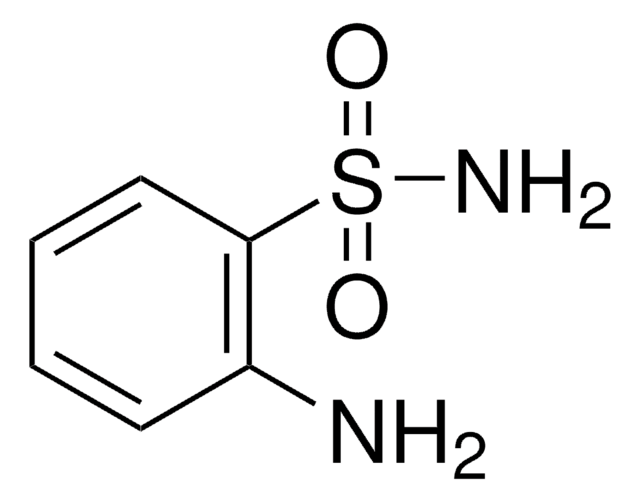S9251
Sulfanilamide
≥98%
Synonyme(s) :
4-aminobenzenesulfonamide, p-Aminobenzenesulfonamide
About This Item
Produits recommandés
Niveau de qualité
Pureté
≥98%
Forme
powder or crystals
Couleur
white to off-white
Pf
164-166 °C (lit.)
Spectre d'activité de l'antibiotique
Gram-negative bacteria
Gram-positive bacteria
Mode d’action
DNA synthesis | interferes
enzyme | inhibits
Chaîne SMILES
Nc1ccc(cc1)S(N)(=O)=O
InChI
1S/C6H8N2O2S/c7-5-1-3-6(4-2-5)11(8,9)10/h1-4H,7H2,(H2,8,9,10)
Clé InChI
FDDDEECHVMSUSB-UHFFFAOYSA-N
Informations sur le gène
human ... CA1(759) , CA2(760) , CA5A(763) , CA5B(11238) , CA9(768)
mouse ... Car13(71934) , Car5a(12352)
Vous recherchez des produits similaires ? Visite Guide de comparaison des produits
Catégories apparentées
Description générale
Actions biochimiques/physiologiques
Mode of Action: A competitive inhibitor of dihydropteroate synthestase to block the synthesis of folic acid.
Anti-microbial Spectrum: Gram positive, Gram negative, Chlamydia
Mode of Resistance: Alteration of dihydropteroate synthase or alternative pathway for folic acid synthesis.
Autres remarques
Code de la classe de stockage
11 - Combustible Solids
Classe de danger pour l'eau (WGK)
WGK 1
Point d'éclair (°F)
Not applicable
Point d'éclair (°C)
Not applicable
Équipement de protection individuelle
Eyeshields, Gloves, type N95 (US)
Choose from one of the most recent versions:
Certificats d'analyse (COA)
Don't see the Right Version?
If you require a particular version, you can look up a specific certificate by the Lot or Batch number.
Déjà en possession de ce produit ?
Retrouvez la documentation relative aux produits que vous avez récemment achetés dans la Bibliothèque de documents.
Les clients ont également consulté
Notre équipe de scientifiques dispose d'une expérience dans tous les secteurs de la recherche, notamment en sciences de la vie, science des matériaux, synthèse chimique, chromatographie, analyse et dans de nombreux autres domaines..
Contacter notre Service technique





